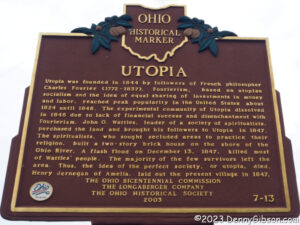 Wednesday is this blog’s day for reviews. Although not every Wednesday gets one, reviews do sometimes appear two or more weeks in a row. In fact, reviews appeared on six consecutive Wednesdays earlier this year. But today is definitely the first time I have ever published back-to-back reviews of premieres of locally produced musicals about local history. In addition to their being musicals with local roots and having me in the audience of their inaugural runs, both Above the Sand (reviewed here) and Utopia, Ohio, the subject of this review, convincingly demonstrate the phenomenal amount of talent in this area. The similarities between the debuts of these two new musicals are striking but there are some pretty big differences between the musicals themselves.
Wednesday is this blog’s day for reviews. Although not every Wednesday gets one, reviews do sometimes appear two or more weeks in a row. In fact, reviews appeared on six consecutive Wednesdays earlier this year. But today is definitely the first time I have ever published back-to-back reviews of premieres of locally produced musicals about local history. In addition to their being musicals with local roots and having me in the audience of their inaugural runs, both Above the Sand (reviewed here) and Utopia, Ohio, the subject of this review, convincingly demonstrate the phenomenal amount of talent in this area. The similarities between the debuts of these two new musicals are striking but there are some pretty big differences between the musicals themselves.
One difference of note is the public’s familiarity with the two subjects. Virtually everyone knows that the Wright brothers were the first humans to successfully fly a heavier-than-air machine, and many residents of southwest Ohio know a lot more of the story than that. But the story of Utopia, an unincorporated community near Cincinnati, is hardly known at all. My guess is that even people who live fairly close to the small cluster of buildings on the banks of the Ohio River know little or nothing beyond what is written on the historical marker in the opening photo and not many stop to read even that.
 Utopia was actually the name of the third and final attempt at communal living at the location. The Clermont Phalanx was first. A “phalanx” was a group of followers of the writings of Charles Fourier. The Clermont Phalanx was formed in 1844 and failed in 1846. Within months of that failure, abolitionist and spiritualist John Wattles established the community of Excelsior on a portion of the phalanx property, and Josiah Warren, “America’s first anarchist”, established Utopia a short time later on another portion. A very good history of all three is available here. Joshua Steele, the writer of Utopia, Ohio, provided a nice summary in a Facebook post here.
Utopia was actually the name of the third and final attempt at communal living at the location. The Clermont Phalanx was first. A “phalanx” was a group of followers of the writings of Charles Fourier. The Clermont Phalanx was formed in 1844 and failed in 1846. Within months of that failure, abolitionist and spiritualist John Wattles established the community of Excelsior on a portion of the phalanx property, and Josiah Warren, “America’s first anarchist”, established Utopia a short time later on another portion. A very good history of all three is available here. Joshua Steele, the writer of Utopia, Ohio, provided a nice summary in a Facebook post here.
 I’ve brought up all of this background stuff because I believe a decent knowledge of the history is necessary to understand the musical. Notice I said “understand” not “enjoy”. Enjoying the musical is easy because the music and performances are so good. In fact, knowing nothing at all about the history would not keep you from enjoying the music. You can appreciate the tunes the same way you appreciate a concert or a new album. All five cast members are talented vocalists. There is no orchestra. Every cast member plays at least one instrument and some play several. The full battery includes guitar, mandolin, piano, accordion, violin, and cajon. Coordinating instruments no doubt complicated the director’s and stage manager’s jobs but it was handled quite well.
I’ve brought up all of this background stuff because I believe a decent knowledge of the history is necessary to understand the musical. Notice I said “understand” not “enjoy”. Enjoying the musical is easy because the music and performances are so good. In fact, knowing nothing at all about the history would not keep you from enjoying the music. You can appreciate the tunes the same way you appreciate a concert or a new album. All five cast members are talented vocalists. There is no orchestra. Every cast member plays at least one instrument and some play several. The full battery includes guitar, mandolin, piano, accordion, violin, and cajon. Coordinating instruments no doubt complicated the director’s and stage manager’s jobs but it was handled quite well.
Coordinating hats also added some complexity. With more roles than actors, hats were used effectively to distinguish specific roles. Linsey Rogers and. Brad Myers were particularly adept at this. At times, images projected at the side of the stage also helped know who was who.
Determining when was when was a different matter. You might be able to tell the players without a program but not the dates. The songs of Utopia, Ohio do not tell a story chronologically, at least not in the order they were performed on Thursday. That is why, I assume, there are dates in the program. It took me way too long to realize this. Once I did, I started taking in the performance more as a concert than a play despite having a pretty good sense of the history of the three failed communities. In the end, I decided that viewing it as a series of related but not ordered musical vignettes was best. Within each vignette, the cast skillfully brought music, lyrics, actions, and expressions together to tell the intended story and to entertain as well.
A very important difference between last week’s review and this one is the fact that Utopia, Ohio‘s first run is not already over. This is being published on the morning of the second of four scheduled performances so I do not feel the too-late-to-matter guilt I did last week. Maybe I will, though, as at least one of the three remaining performances is sold out. Check for tickets here. If you do snag one, my advice is to either pay close attention to the dates in the program and put the history together in your head or ignore them completely and just tap your toes to some fine music.

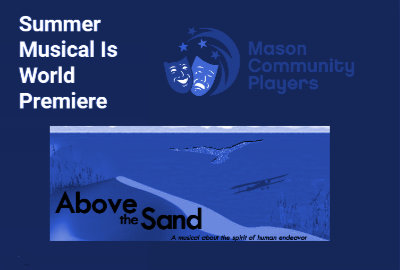 When I wrote about
When I wrote about 
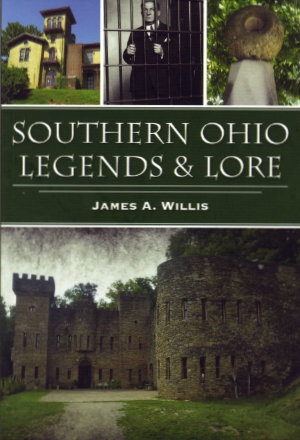
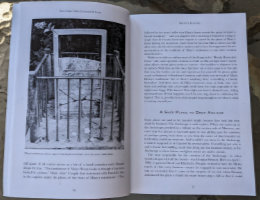 The stories are divided into six sections: “Ghostly Legends”, “Legendary Characters”, “Legendary Villians”, “Legendary Places”, “The Unexplained”, and “Legendary Events”. Having lived my entire life in southern Ohio, I was already at least somewhat familiar with most of them. There are exceptions including all four “Ghostly Legends”. It is the only section where every story is new to me and it is the only section dealing more or less directly with possibly supernatural phenomena. I’m thinking those two facts might very well be related. I’m also thinking that this is the right place to mention that Willis is the founder and director of the paranormal research group The Ghosts of Ohio. I find it somehow reassuring that this is also the only section where that comes into play and even here there is no straying from the “verifiable facts” approach.
The stories are divided into six sections: “Ghostly Legends”, “Legendary Characters”, “Legendary Villians”, “Legendary Places”, “The Unexplained”, and “Legendary Events”. Having lived my entire life in southern Ohio, I was already at least somewhat familiar with most of them. There are exceptions including all four “Ghostly Legends”. It is the only section where every story is new to me and it is the only section dealing more or less directly with possibly supernatural phenomena. I’m thinking those two facts might very well be related. I’m also thinking that this is the right place to mention that Willis is the founder and director of the paranormal research group The Ghosts of Ohio. I find it somehow reassuring that this is also the only section where that comes into play and even here there is no straying from the “verifiable facts” approach.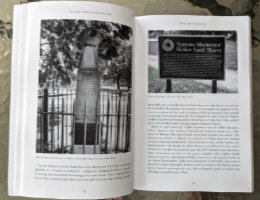 I don’t believe I learned anything new about any of the “Legendary Characters” but I appreciate the concise and complete descriptions. Willis’ reporting on John Symmes and his hollow earth theory is among the most even-handed and comprehensive I’ve read. Likewise, his tale of “Legendary Villian” George Remus where I did learn a few details for the first time.
I don’t believe I learned anything new about any of the “Legendary Characters” but I appreciate the concise and complete descriptions. Willis’ reporting on John Symmes and his hollow earth theory is among the most even-handed and comprehensive I’ve read. Likewise, his tale of “Legendary Villian” George Remus where I did learn a few details for the first time.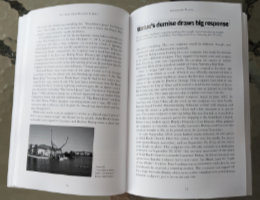 “Legendary Places” combines a place I had never heard of (Athens Pentagram) with three that I am quite familiar with. That somehow makes it my favorite section. One of the three familiar places, the Loveland Castle, was the subject of a blog post here
“Legendary Places” combines a place I had never heard of (Athens Pentagram) with three that I am quite familiar with. That somehow makes it my favorite section. One of the three familiar places, the Loveland Castle, was the subject of a blog post here  In the prologue of Philippines, Palau, and Guam, Matt Cohen says he considered but discarded the idea of organizing the book along the lines of the Philipines’ four ‘B’s — basketball, beauty contests, boxing, and beaches. I guess that was on my mind as I scanned it for the first time and found myself registering three ‘C’s — color, culture, and composition.
In the prologue of Philippines, Palau, and Guam, Matt Cohen says he considered but discarded the idea of organizing the book along the lines of the Philipines’ four ‘B’s — basketball, beauty contests, boxing, and beaches. I guess that was on my mind as I scanned it for the first time and found myself registering three ‘C’s — color, culture, and composition.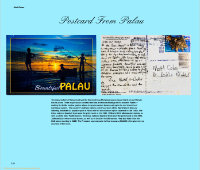
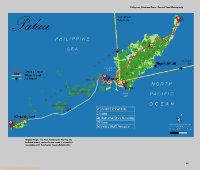 Although it is not presented as such, the book really is a travelogue of sorts. Most if not all of the travel photos were taken during a single extended trip taken by the author and his wife in early 2023. After deciding not to use the four ‘B’s as organizing tools, Cohen went with a fairly straightforward geographical organization. The Philippines gets three chapters covering the three areas where they spent the most time. These are Manila, North Luzon, and Cebu/Bohol. Palau and Guam each get their own chapter. Each chapter begins with an actual postcard that the Cohens mailed to themselves from the region covered by the chapter accompanied by a brief description of the region. A map, with locations of interest marked, follows.
Although it is not presented as such, the book really is a travelogue of sorts. Most if not all of the travel photos were taken during a single extended trip taken by the author and his wife in early 2023. After deciding not to use the four ‘B’s as organizing tools, Cohen went with a fairly straightforward geographical organization. The Philippines gets three chapters covering the three areas where they spent the most time. These are Manila, North Luzon, and Cebu/Bohol. Palau and Guam each get their own chapter. Each chapter begins with an actual postcard that the Cohens mailed to themselves from the region covered by the chapter accompanied by a brief description of the region. A map, with locations of interest marked, follows. The chapters are then filled with pictures of people, places, and things accompanied by text ranging from a few words to a few paragraphs. Most questions I had when first encountering a photo were answered in nearby text. The places pictured range from mountains to markets. Things range from colorful new balloons offered for sale to an abandoned Japanese tank slowly being claimed by foliage. People include unnamed workers, islanders in native dress, a mayor, a governor, a president, and a would-be bride left at the altar.
The chapters are then filled with pictures of people, places, and things accompanied by text ranging from a few words to a few paragraphs. Most questions I had when first encountering a photo were answered in nearby text. The places pictured range from mountains to markets. Things range from colorful new balloons offered for sale to an abandoned Japanese tank slowly being claimed by foliage. People include unnamed workers, islanders in native dress, a mayor, a governor, a president, and a would-be bride left at the altar.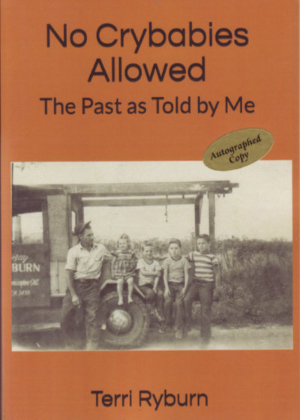 I know Terri Ryburn as the owner of historic Sprague’s Super Service in Normal, Illinois, and as a key ingredient in the Miles of Possibility Route 66 Conferences. I know the picture on the cover of the book from a copy hanging on the wall of the former gas station that Ryburn has turned into a Route 66 information center, gift shop, and photo op. I knew that was Terri seated on the fender with her dad and older brothers standing beside her because she told me when I spotted the photo on the wall. She may have told me that the photo contained only half of her total family but if she did I forgot. From reading No Crybabies Allowed I learned (or maybe relearned) that, while Terri was the youngest family member in this particular photo, she would be in the elder half of eight children after two more brothers and two sisters came along. None were crybabies.
I know Terri Ryburn as the owner of historic Sprague’s Super Service in Normal, Illinois, and as a key ingredient in the Miles of Possibility Route 66 Conferences. I know the picture on the cover of the book from a copy hanging on the wall of the former gas station that Ryburn has turned into a Route 66 information center, gift shop, and photo op. I knew that was Terri seated on the fender with her dad and older brothers standing beside her because she told me when I spotted the photo on the wall. She may have told me that the photo contained only half of her total family but if she did I forgot. From reading No Crybabies Allowed I learned (or maybe relearned) that, while Terri was the youngest family member in this particular photo, she would be in the elder half of eight children after two more brothers and two sisters came along. None were crybabies.







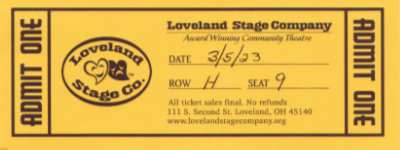 Loveland Stage Company was founded in 1979. I lived inside Loveland city limits from about 1981 to 1997. I visited the town frequently before I physically moved there and visit even more frequently now that I’ve moved a few miles away. I have driven by the LSC theater perhaps hundreds of times. I have seen many interesting titles displayed on that marquee. That I’d not previously been inside is both inexplicable and inexcusable. The performance I saw Sunday compares favorably with some I’ve seen in downtown Cincinnati. Walkable restaurants around LSC also compare favorably with those around the downtown theaters and the parking is cheaper. There’s some Shakespeare (Twelfth Night) coming up at LSC in a couple of months which I hope to catch. I’m also quite curious about what next season will bring.
Loveland Stage Company was founded in 1979. I lived inside Loveland city limits from about 1981 to 1997. I visited the town frequently before I physically moved there and visit even more frequently now that I’ve moved a few miles away. I have driven by the LSC theater perhaps hundreds of times. I have seen many interesting titles displayed on that marquee. That I’d not previously been inside is both inexplicable and inexcusable. The performance I saw Sunday compares favorably with some I’ve seen in downtown Cincinnati. Walkable restaurants around LSC also compare favorably with those around the downtown theaters and the parking is cheaper. There’s some Shakespeare (Twelfth Night) coming up at LSC in a couple of months which I hope to catch. I’m also quite curious about what next season will bring. Amy E. Brownlee is a lifelong Cincinnatian. She naturally learned a lot about the city growing up here then used that knowledge and added much more during her ten years at Cincinnati Magazine. An awful lot of the treasures she writes about in Lost Treasures of Cincinnati were lost before she arrived but a rather frightening number have disappeared during her lifetime. Of course, an even larger number have disappeared during mine. Neither of us is responsible for that. I swear it’s coincidence pure and simple.
Amy E. Brownlee is a lifelong Cincinnatian. She naturally learned a lot about the city growing up here then used that knowledge and added much more during her ten years at Cincinnati Magazine. An awful lot of the treasures she writes about in Lost Treasures of Cincinnati were lost before she arrived but a rather frightening number have disappeared during her lifetime. Of course, an even larger number have disappeared during mine. Neither of us is responsible for that. I swear it’s coincidence pure and simple. The book opens with “Food and Drink” in Section 1 then covers “Entertainment” and “Retail” in the next two sections. The smallest section, “Media”, is followed by the largest, “Community”. Definitions for those section titles are not particularly rigid and the size of the “Community” section probably indicates that it is the least rigid of all. It is where things like churches and breweries, of which Cincinnati had more than a few, appear.
The book opens with “Food and Drink” in Section 1 then covers “Entertainment” and “Retail” in the next two sections. The smallest section, “Media”, is followed by the largest, “Community”. Definitions for those section titles are not particularly rigid and the size of the “Community” section probably indicates that it is the least rigid of all. It is where things like churches and breweries, of which Cincinnati had more than a few, appear.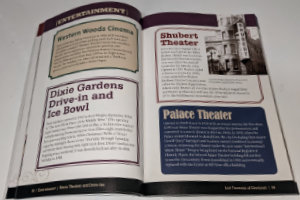 Most, but not quite all, of the breweries mentioned in the book were gone before I got here. Likewise with restaurants and attractions which together comprise the biggest part of things that have disappeared during my lifetime. I caught one show, Hair, at the Shubert (“Entertainment”) before it was torn down. I also saw one movie at the Albee (“Entertainment”) but I don’t remember what it was. I had one meal each at The Gourmet Room and the Maisonette (“Food and Drink”) before they closed. There are quite a few places in this book where I ate one or more meals or watched one or more movies, plays, games, or concerts. Encountering each of them on these pages prompted memories that went way beyond the single paragraph of text. Reading about places that were already gone when I came to Cincinnati didn’t prompt any memories, of course, but it did make me appreciate just how many treasures have been lost.
Most, but not quite all, of the breweries mentioned in the book were gone before I got here. Likewise with restaurants and attractions which together comprise the biggest part of things that have disappeared during my lifetime. I caught one show, Hair, at the Shubert (“Entertainment”) before it was torn down. I also saw one movie at the Albee (“Entertainment”) but I don’t remember what it was. I had one meal each at The Gourmet Room and the Maisonette (“Food and Drink”) before they closed. There are quite a few places in this book where I ate one or more meals or watched one or more movies, plays, games, or concerts. Encountering each of them on these pages prompted memories that went way beyond the single paragraph of text. Reading about places that were already gone when I came to Cincinnati didn’t prompt any memories, of course, but it did make me appreciate just how many treasures have been lost.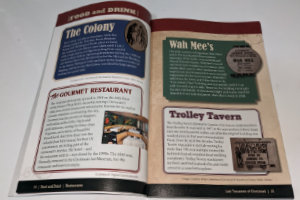 I really enjoyed reading Lost Treasures of Cincinnati cover-to-cover front-to-back but as I did, two other ways of reading the book came to mind. With its fairly short standalone essays, it seems like a natural fit for that popular personal reading room with the porcelain furniture. Its use as a reference book also seems rather natural. I don’t mean an every-last-detail reference book to use in conducting deep-dive research but a great place to answer questions like “What was the name of that boat-shaped restaurant?” or “What happened to our NBA team?”. The full index will help the book play that role.
I really enjoyed reading Lost Treasures of Cincinnati cover-to-cover front-to-back but as I did, two other ways of reading the book came to mind. With its fairly short standalone essays, it seems like a natural fit for that popular personal reading room with the porcelain furniture. Its use as a reference book also seems rather natural. I don’t mean an every-last-detail reference book to use in conducting deep-dive research but a great place to answer questions like “What was the name of that boat-shaped restaurant?” or “What happened to our NBA team?”. The full index will help the book play that role.






